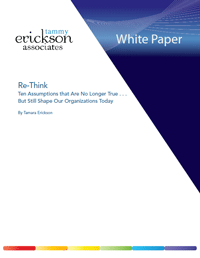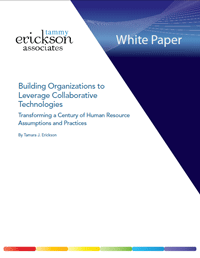Re-Think Ten Assumptions that Are No Longer True…But Still Shape Our Organizations Today
Have you ever found yourself wondering “why do we do it this way?†If not, you should. Most of today’s business organizations are perfectly designed . . . to respond to conditions that no longer exist. The ways we’ve always done things – the approaches we grew up accepting as the normal order of things – simply don’t make sense anymore. They are predicated on a set of underlying assumptions that are not valid today. These assumptions were all true in the first half of the Twentieth Century, when modern organizations were designed. None are true today. All have major implications for the way we lead, design organizations, and manage talent. Today’s organizations are ripe for change. It’s time to re-think ten key assumptions.
To download your free copy of Re-Think Ten Assumptions that Are No Longer True…But Still Shape Our Organizations Today, complete the form at right. Or, take a look at the excerpt below to sample the research included in this white paper.
Excerpt from Re-Think Ten Assumptions that Are No Longer True…But Still Shape Our Organizations Today:
...
Rethink: Talent Availability
Old Assumptions: There will always be a line of young people (qualified young people) outside my door, eager for a job – particularly at a “good†company like ours. The population is shaped like a pyramid, with more young than old people.
The assumptions of a population pyramid and the accompanying notion of there being more young people than old are not true in many countries today and, increasingly, won’t be true throughout much of the world. The combination of longer life expectancies and lower birth rates has conspired to give us increasingly diamond- or rectangular-shaped populations – and a growing shortage of young workers.
Birth rates are dramatically lower than they were just a few decades ago. These rates are falling below replacement levels, toward 1.85 children per woman, in many parts of the world. At the same time, life expectancies are increasing dramatically. Human life expectancy averaged 35 years for most of the last 1000 years of man’s history on earth, but has more than doubled to 75-80 years today.
New Reality: The workforce is becoming an inverted pyramid, with more older people than young. Young hires, particularly college graduates, will be in short supply.
The implications of this new reality, a re-proportioned workforce, include the need to:
- Develop the capabilities required to attract a disproportionate share of available talent
- Re-think career paths, moving away from using movement “up†as the only way to provide additional learning, variety, compensation or recognition
- Eliminate mandatory retirement
- Develop approaches to leverage older workers effectively, including increasing development investments at all stages and bell-shaped curve career path options (a “deceleration†phase through one’s 60’s, 70’s and even 80’s)
- Help the generations work together effectively
...
To continue reading Re-Think Ten Assumptions that Are No Longer True…But Still Shape Our Organizations Today, complete the form at right to download your free copy.














